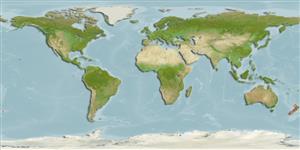>
Gobiiformes (Gobies) >
Eleotridae (Bully sleepers)
Etymology: Gobiomorphus: Latin, gobius = gudgeon + Greek, morphe = shape (Ref. 45335).
Environment: milieu / climate zone / depth range / distribution range
Écologie
marin; eau douce; saumâtre démersal; amphidrome (Ref. 51243). Subtropical; 4°C - 22°C (Ref. 13614); 34°S - 47°S
Oceania: endemic to New Zealand.
Taille / Poids / Âge
Maturity: Lm ? range ? - ? cm
Max length : 15.0 cm TL mâle / non sexé; (Ref. 13614)
Occurs in various habitats such as small hypertrophic lakes, large oligotrophic lakes and lower reaches of rivers. Amphidromous (Ref. 11115). Feeds on a wide variety of benthic invertebrates.
Life cycle and mating behavior
Maturité | Reproduction | Frai | Œufs | Fécondité | Larves
McDowall, R.M., 1990. Freshwater fishes and fisheries of New Zealand -The angler's el dorado. Aquat. Sci. 2(2):281-341. (Ref. 11115)
Statut dans la liste rouge de l'IUCN (Ref. 130435)
Menace pour l'homme
Harmless
Utilisations par l'homme
Plus d'informations
Taille/ÂgeCroissanceLongueur-poidsLongueur-longueurFréquences de longueursMorphométrieMorphologieLarvesDynamique des populations larvairesRecrutementAbondanceBRUVS
RéférencesAquacultureProfil d'aquacultureSouchesGénétiqueElectrophoresesHéritabilitéPathologiesTraitementNutrientsMass conversion
CollaborateursImagesStamps, Coins Misc.SonsCiguateraVitesseType de nageSurface branchialeOtolithesCerveauxVision
Outils
Articles particuliers
Télécharger en XML
Sources Internet
Estimates based on models
Preferred temperature (Ref.
123201): 11.9 - 19.1, mean 16 °C (based on 116 cells).
Phylogenetic diversity index (Ref.
82804): PD
50 = 0.5020 [Uniqueness, from 0.5 = low to 2.0 = high].
Bayesian length-weight: a=0.00537 (0.00260 - 0.01111), b=3.09 (2.90 - 3.28), in cm total length, based on LWR estimates for this (Sub)family-body shape (Ref.
93245).
Niveau trophique (Ref.
69278): 3.3 ±0.1 se; based on diet studies.
Résilience (Ref.
120179): Milieu, temps minimum de doublement de population : 1,4 à 4,4 années (Fec=200-2,000).
Fishing Vulnerability (Ref.
59153): Low vulnerability (10 of 100).
